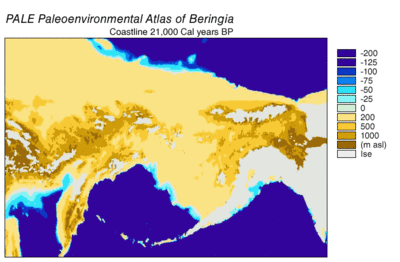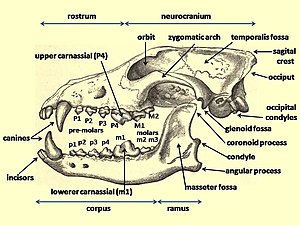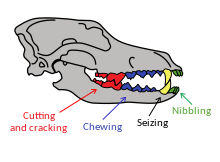Beringian wolf
| Beringian wolf Temporal range:
YBP ) | |
|---|---|

| |
| Two models of Beringian wolves created by paleo-artists working at the Yukon Beringia Interpretive Centre | |
| Scientific classification | |
| Domain: | Eukaryota |
| Kingdom: | Animalia |
| Phylum: | Chordata |
| Class: | Mammalia |
| Order: | Carnivora |
| Family: | Canidae |
| Genus: | Canis |
| Species: | C. lupus |
| Population: | †Beringian wolf |

The Beringian wolf is an extinct
The Beringian wolf was similar in size to the modern
At the close of the Ice Age, with the loss of cold and dry conditions and the extinction of much of its prey, the Beringian wolf became extinct. The extinction of its prey has been attributed to the impact of
Taxonomy
From the 1930s representatives of the
Gray wolves were widely distributed across North American during both the Pleistocene and historic period.[6] In 2007 Jennifer Leonard undertook a study based on the genetic, morphology, and stable isotope analyses of seventy-four Beringian wolf specimens from Alaska and the Yukon that revealed the genetic relationships, prey species, and feeding behavior of prehistoric wolves, and supported the classification of this wolf as C. lupus.[7][8] The specimens were not assigned a subspecies classification by Leonard, who referred to these as "eastern Beringian wolves".[9] A subspecies was possibly not assigned because the relationship between the Beringian wolf and the extinct European cave wolf (C. l. spelaeus) is not clear. Beringia was once an area of land that spanned the Chukchi Sea and the Bering Sea, joining Eurasia to North America. Eastern Beringia included what is today Alaska and the Yukon.[10]
Lineage
Basal wolf
As of 2020, the oldest known intact wolf remains belongs to a mummified pup dated 56,000 YBP that was recovered from the permafrost along a small tributary of Last Chance Creek near Dawson City, Yukon, Canada. A DNA analysis showed that it belonged to the Beringian wolf clade, that the most recent common ancestor of this clade dates to 86,700–67,500 YBP, and that this clade was basal to all other wolves except for the Himalayan wolf.[12]
Different genetic types of gray wolf
| Phylogenetic tree with timing in years for Canis lupus[a] | |||||||||||||||||||||||||||
|
A
| Phylogenetic tree for wolves | ||||||||||||||||||||||||||||||
| ||||||||||||||||||||||||||||||
| Simplified mDNA phylogeny for modern wolves and extinct Beringian wolves[8][19] |
A 2010 study compared mDNA sequences of modern wolves with those from 24 ancient wolf specimens from western Europe dated between 44,000 and 1,200
A scenario consistent with the phylogenetic, ice sheet size, and sea-level depth data is that during the Late Pleistocene the sea levels were at their lowest. A single wave of wolf colonization into North America commenced with the opening of the

The Beringian wolves are morphologically and genetically comparable to Late Pleistocene European wolves.
It is possible that a
Description

Olsen described the short-faced wolf skulls as follows:
The proportions of the skulls of these wolves that vary do so in the rostral area. The area of the skull that is anterior to the infraorbital foramen is noticeably foreshortened and constricted laterally in several of the skulls...Dishing of the rostrum, when viewed laterally, is evident in all of the short-faced skulls identified as Canis lupus from the Fairbanks gold fields. The occipital and supraoccipital crests are noticeably diminished compared to those found in average specimens of C. lupus. The occipital overhang of these crests, a wolf characteristic, is about equal in both groups of C. lupus...Examination of a large series of recent wolf skulls from the Alaskan area did not produce individuals with the same variations as those from the Fairbanks gold fields.[5]
The Beringian wolf was similar in size to the modern
During the Late Pleistocene, the more southerly occurring dire wolf (Aenocyon dirus) had the same shape and proportions as the Yukon wolf,[33][34] but the dire wolf subspecies A. dirus guildayi is estimated to have weighed on average 60 kg (130 lb), and the subspecies A. dirus dirus on average 68 kg (150 lb), with some specimens being larger.[35] The dire wolf was heavier than the Beringian wolf and possessed a more robust skull and dentition.[8]
Adaptation
Paleoecology

The
During the Ice Age a vast, cold and dry mammoth steppe stretched from the Arctic islands southwards to China, and from Spain eastwards across Eurasia and over the Bering land bridge into Alaska and the Yukon, where it was blocked by the Wisconsin glaciation. The land bridge existed because sea levels were lower due to more of the planet's water being locked up in glaciers compared with today. Therefore, the flora and fauna of Beringia were more related to those of Eurasia rather than to those of North America.[44][45] In eastern Beringia from 35,000 YBP the northern Arctic areas experienced temperatures 1.5 °C (2.7 °F) warmer than today, but the southern sub-Arctic regions were 2 °C (3.5 °F) cooler. In 22,000 YBP, during the Last Glacial Maximum, the average summer temperature was 3–5 °C (5.4–9 °F) cooler than today, with variations of 2.9 °C (5.2 °F) cooler on the Seward Peninsula to 7.5 °C (13.5 °F) cooler in the Yukon.[46]
Beringia received more moisture and intermittent maritime cloud cover from the north Pacific Ocean than the rest of the Mammoth steppe, including the dry environments on either side of it. Moisture occurred along a north–south gradient with the south receiving the most cloud cover and moisture due to the airflow from the North Pacific.
Prey

Isotope analysis can be used to allow researchers to make inferences about the diet of the species being studied. Two isotope analyses of bone collagen extracted from the remains of Late Pleistocene wolves found in Beringia and Belgium indicate that wolves from both areas preyed mainly on Pleistocene megafauna,[8][19][51] which became rare at the beginning of the Holocene 12,000 years ago.[19][52] The Beringian wolf preyed most often on horse and steppe bison.[8][18] In the period leading up to the Last Glacial Maximum (50,000 YBP–23,000 YBP), they also ate woodland muskox, and after this time they also ate mammoth. The analysis supports the conclusion that these wolves were capable of killing and dismembering large prey.[8]
In another stable isotope analysis, half of the Beringian wolves were found to be musk ox and caribou specialists, and the other half were either horse and bison specialists or generalists. Two wolves from the full-glacial period (23,000–18,000 YBP) were found to be mammoth specialists, but it is not clear if this was due to scavenging or predation. The analysis of other carnivore fossils from the Fairbanks region of Alaska found that mammoth was rare in the diets of the other Beringian carnivores.[10]
A stable isotope analysis of a mummified Beringian wolf pup dated 56,000 YBP that was recovered near the Klondike river revealed that most of its diet - and therefore its mother's diet - was based on aquatic rather than animal resources. The aquatic resources was proposed to be salmon.[12]
Dentition
A 2007 study of
An accepted sign of domestication is the presence of tooth crowding, in which the orientation and alignment of the teeth are described as touching, overlapping or being rotated. However, a 2017 study found that 18% of Beringian wolf specimens exhibit tooth crowding compared with 9% for modern wolves and 5% for domestic dogs. These specimens predate the arrival of humans and therefore there is no possibility of cross-breeding with dogs. The study indicates that tooth crowding can be a natural occurrence in some wolf ecomorphs and cannot be used to differentiate ancient wolves from early dogs.[54]

| Tooth variable | modern North America | Rancho La Brea | Eastern Beringia |
|---|---|---|---|
| premolar row length | 63.4 | 63.6 | 69.3 |
| palate width | 64.9 | 67.6 | 76.6 |
| P4 length | 25.1 | 26.3 | 26.7 |
| P4 width | 10.1 | 10.6 | 11.4 |
| M1 length | 16.4 | 16.5 | 16.6 |
| M2 length | 8.7 | 8.9 | 9.2 |
| m1 length | 28.2 | 28.9 | 29.6 |
| m1 trigonid length
|
19.6 | 21.9 | 20.9 |
| m1 width | 10.7 | 11.3 | 11.1 |
Tooth breakage

Tooth breakage is related to a carnivore's behavior.
Competitors
In addition to the Beringian wolf, other Beringian carnivores included the
A 1993 study proposed that the higher frequency of tooth breakage among Pleistocene carnivores compared with living carnivores was not the result of hunting larger game, something that might be assumed from the larger size of the former. When there is low prey availability, the competition between carnivores increases, causing them to eat faster and consume more bone, leading to tooth breakage.[55][61][62] Compared to modern wolves, the high frequency of tooth fracture in Beringian wolves indicates higher carcass consumption due to higher carnivore density and increased competition.[8] This proposal was challenged in 2019, when a survey of modern wolf behavior over the past 30 years showed that when there was less prey available, the rates of tooth fracture more than doubled. This suggests that large Pleistocene carnivores experienced more periods of limited food availability when compared with their modern counterparts.[63]
Range

The remains of Beringian wolves have been found in Alaska and as far eastward as the Yukon in Canada.[9] Specimens that have been identified by their skull morphology[9] and limb morphology[64] to be Beringian wolves have been found in the Natural Trap Cave at the base of the Bighorn Mountains in Wyoming, United States. These were radiocarbon dated to between 25,800 and 14,300 YBP, and this location is directly south of what would at that time have been the division between the Laurentide Ice Sheet and the Cordilleran Ice Sheet. This suggests that a temporary channel existed between the glaciers from 25,800 YBP[9] until the advance of the ice sheets 16,000–13,000 YBP.[9][65] The migration of the Beringian wolf southwards is assumed to have been the result of pursuing prey species, as this cave also contained specimens of steppe bison that had migrated from Beringia and would have been prey for wolves,[9][66] and musk ox that is known to be an important prey species of the Beringian wolf.[9][10] Dire wolves were absent north of 42°N latitude in the Late Pleistocene; therefore, this region would have been available for Beringian wolves to expand southwards. There is no evidence of expansion beyond this region.[9]
Extinction
Extinction is the result of the elimination of the geographic range of a species with a reduction of its population size down to zero. The factors that affect biogeographic range and population size include competition, predator-prey interactions, variables of the physical environment, and chance events.[67]
Phenotype is extinct
A

Postglacial environmental change throughout eastern Beringia brought about wholesale changes in vegetation, the regional extinction of much of the megafauna, and the entrance of
The radiocarbon dating of the skeletal remains from 56 Beringian wolves showed a continuous population from over 50,800 YBP[21] until 12,500 YBP, followed by one wolf dated at 7,600 YBP. This indicates that their population was in decline after 12,500 YBP,[8] although megafaunal prey was still available in this region until 10,500 YBP.[75] The timing of this latter specimen is supported by the recovery of mammoth and horse DNA from sediments dated 10,500 YBP–7,600 YBP from the interior of Alaska,[75] and steppe bison dated 5,400 YBP from the Yukon.[76] The timing for the extinction of horses in North America and the minimum population size for North American bison coincide with the extinction of an entire wolf haplogroup in North America, indicating that the disappearance of their prey caused the extinction of this wolf ecomorph.[16][18] This resulted in a significant loss of phenotypic and genetic diversity within the species.[8]
Haplotype is not extinct
There are parts of Central Eurasia where the environment is considered to be stable over the past 40,000 years.
Descendants
In 2021, an mDNA analysis of modern and extinct North American wolf-like canines indicates that the Beringian wolf was the ancestor of the southern wolf clade, which includes the Mexican wolf and the extinct Great Plains wolf. The Mexican wolf is the most ancestral of the gray wolves that live in North America today. The modern coyote appeared around 10,000 years ago. The most genetically basal coyote mDNA clade pre-dates the Late Glacial Maximum and is a haplotype that can only be found in the Eastern wolf. This implies that the large, wolf-like Pleistocene coyote was the ancestor of the Eastern wolf. Further, another ancient haplotype detected in the Eastern wolf can be found only in the Mexican wolf. The study proposes that Pleistocene coyote and Beringian wolf admixture led to the Eastern wolf long before the arrival of the modern coyote and the modern wolf.[78]
Notes
- ^ For a full set of supporting references refer to the note (a) in the phylotree at Evolution of the wolf#Wolf-like canids
References
- hdl:2246/6354.
- ^ Chaney, R.; Mason, H. (1936). "The Pleistocene flora of Fairbanks, Alaska". American Museum Novitates (887): 5. Archived from the original on 2018-02-03. Retrieved 2018-02-03.
- ISBN 978-0-89338-007-6. Retrieved 31 January 2018.
- ISBN 978-0-521-40214-9.
- ^ a b Stanley J. Olsen (1985). Origins of the Domestic Dog: The Fossil Record – Chapter 2. University of Arizona Press. p. 22.
- ^ ISBN 978-0-226-50672-2.
- ISBN 978-0-85702-360-5.
- ^ S2CID 14039133. Archived from the original(PDF) on 2016-12-28. Retrieved 2015-08-28.
- ^ PMID 27252837.
- ^ .
- ISBN 978-1-4860-0704-2.
- ^ S2CID 229346357.
- ISBN 978-1-118-96858-1.
- ISBN 978-93-81588-64-2.
- ^ PMID 26229286.
- ^ ISBN 978-0-19-954566-7.
- ^ S2CID 11343074.
- ^ ISBN 978-0-19-953509-5.
- ^ PMID 20409299.
- .
- ^ .Refer Page 5 with Table S3, relationship between Clu108(Russia 18,000) and Clu109(Alaska28,000) with Clu8,9,10,22(China).
- S2CID 1526260.
- ^ S2CID 88740690.
- .
- S2CID 31680635. Refer Table 1
- . Retrieved 20 May 2017.
- ^ a b c Leonard, Jennifer (2014). "Ecology drives evolution in grey wolves" (PDF). Evolution Ecology Research. 16: 461–473. Archived from the original (PDF) on 2016-04-15. Retrieved 2016-05-21.
- ^ Wolpert, Stuart (November 14, 2013). "Dogs likely originated in Europe more than 18,000 years ago, UCLA biologists report". UCLA News Room. Retrieved December 10, 2014.
- ^ S2CID 14268297.
- ^ ISBN 978-1-4102-0249-9. Retrieved 1 May 2017.
- ^ "Gray wolf (in the Yukon)" (PDF). Environment Yukon. Government of Canada. 2017. Retrieved 18 April 2017.
- PMID 22371581.
- S2CID 83594819.
- ^ Merriam, J. C. (1912). "The fauna of Rancho La Brea, Part II. Canidae". Memoirs of the University of California. 1: 217–273.
- S2CID 83702167.
- OCLC 24875357.
- ^ .
- .
- ISBN 978-0-691-17587-4.
- ^ a b Intergovernmental Panel on Climate Change (UN) (2007). IPCC Fourth Assessment Report: Climate Change 2007 – Palaeoclimatic Perspective (Report). The Nobel Foundation.
- ^ S2CID 1324559.
- .
- S2CID 130031864.
- ^ .
- ^ .
- ^ ISBN 978-0-444-52747-9. Retrieved 2 May 2017.
- ISBN 978-0-231-13060-8.
- S2CID 7209566.
- .
- .
- .
- PMID 20409351.
- S2CID 20955499.
- .
- ^ S2CID 39657617.
- .
- S2CID 222330098.
- ^ a b c DeSantis, L.R.G.; Schubert, B.W.; Schmitt-Linville, E.; Ungar, P.; Donohue, S.; Haupt, R.J. (September 15, 2015). John M. Harris (ed.). "Dental microwear textures of carnivorans from the La Brea Tar Pits, California and potential extinction implications". Contributions in Science. Science Series 42 (A Special Volume Entitled la Brea and Beyond: The Paleontology of Asphalt-Preserved Biotas in Commemoration of the 100th Anniversary of the Natural History Museum of Los Angeles County's Excavations at Rancho la Brea). Natural History Museum of Los Angeles County: 37–52. Retrieved July 21, 2019.
- .
- PMID 28060931.
- ^ a b O'Keefe, F.Robin; Binder, Wendy J.; Frost, Stephen R.; Sadlier, Rudyard W.; Van Valkenburgh, Blaire (2014). "Cranial morphometrics of the dire wolf, Canis dirus, at Rancho La Brea: temporal variability and its links to nutrient stress and climate". Palaeontologia Electronica. 17 (1): 1–24.
- .
- PMID 31549963.
- PMID 29343558.
- S2CID 140156890.
- S2CID 27134675.
- ^ Stanley, Steven M. (1987). Extinction. Scientific American Library. p. 242.
- ISBN 978-0-691-17587-4.
- ISBN 978-0-691-17587-4.
- S2CID 128107590. Retrieved 2019-07-21.
- ISBN 978-0-8137-5203-7.
- ISBN 978-0-231-07091-1.
- ^ Brannick, Alexandria L.; Meachen, Julie A.; O'Keefe, F. Robin (September 15, 2015). John M. Harris (ed.). "Microevolution of Jaw Shape in the Dire Wolf, Canis dirus, at Rancho La Brea". Contributions in Science. Science Series 42 (A Special Volume Entitled la Brea and Beyond: The Paleontology of Asphalt-Preserved Biotas in Commemoration of the 100th Anniversary of the Natural History Museum of Los Angeles County's Excavations at Rancho la Brea). Natural History Museum of Los Angeles County: 23–32.
- S2CID 31686497.
- ^ PMID 20018740.
- S2CID 54951935.
- PMID 24454791.
- PMID 34257949.
External links
- Beringian wolf mandible dated 31,700 YBP showing large, sharp lower carnassial – Museum of the North, University of Alaska (Arctos database)
- Beringian wolf mandible dated 31,700 YBP – other side view of the specimen above
- Beringian Research Notes – Ancient Northern Wolves Government of the Yukon
- Ice Age Mammals of the Yukon Government of the Yukon
